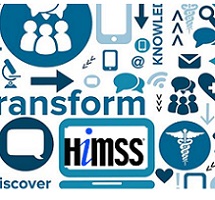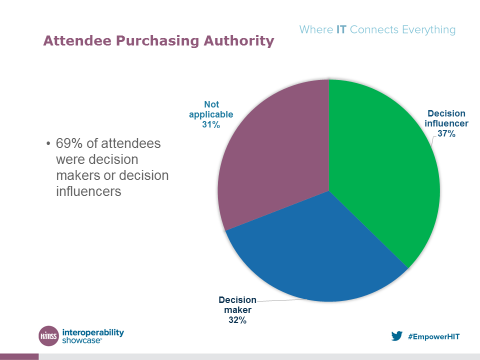 HIMSS Interoperability Showcase™ Attendance Indicates Interoperability a Priority with HIMSS17 Attendees
HIMSS Interoperability Showcase™ Attendance Indicates Interoperability a Priority with HIMSS17 Attendees
HIMSS (@HIMSS) saw a spike in healthcare leaders’ interest in interoperability education at the 2017 HIMSS Conference & Exhibition, according to attendance data from the event. Compared to HIMSS16, attendance more than doubled at the redesigned HIMSS Interoperability Showcase™, a 34,000-square-foot exhibition displaying, in real-time, the exchange and use of data through interoperability profiles and standards with live products currently in the marketplace. The showcase featured interoperability use cases related to surgery and recovery, diabetes management, connected care, childbirth and federal health architecture initiatives, among others.
Out of almost 1,300 exhibits and more than 300 education sessions covering topics, such as government and policy, cybersecurity and new payment models, approximately 7,500 attendees prioritized the HIMSS Interoperability Showcase, a significant increase over the year prior. Total visits to the showcase exceeded 10,000, with visitors staying for an average of 20-60 minutes, far longer than the industry average of seven minutes spent at most exhibitor booths. Additionally, more than two-thirds of showcase attendees were clinicians, healthcare leaders (C-suite, VP, etc.), government and IT professionals – underscoring the importance of interoperability education among practitioners and decision-makers.

Interoperability remains one of the biggest challenges – and opportunities – facing healthcare today. Interoperability enables health information systems to work together within and across traditional organizational boundaries to effectively deliver healthcare to individuals and communities. It allows individuals, families and healthcare providers to have appropriate access to health information that facilitates informed decision-making, supports coordinated health management, allows patients to have an active role in their healthcare and improves the overall health of populations. Despite these clear benefits, interoperability remains a challenge in healthcare – underscoring the need for continued resources, tools and education.
“Every stakeholder in the care delivery process – from patients and practitioners to solution providers and beyond – stands to benefit from interoperable systems built on standards around data exchange, terminology and reporting,” said Christel Anderson, MA, senior director, Interoperability Initiatives, Informatics, for HIMSS North America. “While work remains to achieve nationwide healthcare interoperability, we experienced increased interest in the showcase from stakeholders across the care spectrum. Clearly, interoperability education is a top priority for today’s healthcare leaders.”
Held Feb. 19–23 in Orlando, Fla., HIMSS17 brought together nearly 42,300 health IT professionals, clinicians, executives and vendors from around the world. Attendees explored education programs, feature keynotes, thought leader sessions, roundtable discussions and workshops. Learn more about the Interoperability Showcase.
About HIMSS
HIMSS is a global voice, advisor, convener, and thought leader of health transformation through the best use of IT with a unique breadth and depth of expertise and capabilities to improve the quality, safety, and cost-effectiveness of health and healthcare. Through its network of over 1 million professionals, including 64,000-plus members, HIMSS advises leaders, stakeholders and influencers globally on IT best practices to ensure decision-makers have the right information at the right time to make the right decisions. HIMSS North America, HIMSS Analytics, Personal Connected Health Alliance, HIMSS Media and HIMSS International (HIMSS Europe, HIMSS Asia and HIMSS Middle East) are the five business units of HIMSS. A not-for-profit headquartered in Chicago, Illinois, HIMSS has additional offices in North America, Europe, United Kingdom and Asia.
